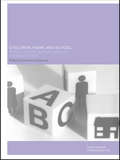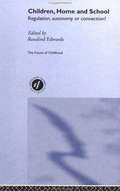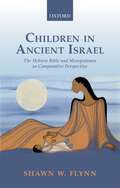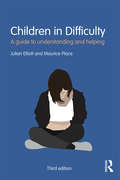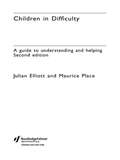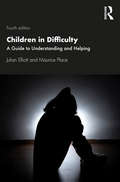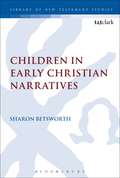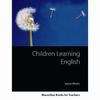- Table View
- List View
Children, Home and School: Regulation, Autonomy or Connection?
by Ros EdwardsIn contemporary western societies, there are increasing emphases on children being the responsibility of their parents, contained within the home, and on their compartmentalisation into separate and protected organised educational settings. Thus 'home' and 'school' form a crucial part of children's lives and experiences.This book explores the key institutional settings of home and school, and other educationally linked organised spaces, in children's lives, and the relationships between these. It presents in-depth discussions concerning new research findings from a range of national contexts and focuses on various aspects of children's, and sometimes adult's, own understandings and activities in home and school, and after school settings, and the relationship between these. The contributors assess children from a variety of backgrounds and circumstances and consider how these children see and position themselves as autonomous within, connected to or regulated by home and school. Discussion of the impact of policy and practice developments on the everyday lives of these children is also included.
Children, Home and School: Regulation, Autonomy or Connection? (PDF)
by Rosalind EdwardsIn contemporary western societies, there are increasing emphases on children being the responsibility of their parents, contained within the home, and on their compartmentalisation into separate and protected organised educational settings. Thus 'home' and 'school' form a crucial part of children's lives and experiences. This book explores the key institutional settings of home and school, and other educationally linked organised spaces, in children's lives, and the relationships between these. It presents in-depth discussions concerning new research findings from a range of national contexts and focuses on various aspects of children's, and sometimes adult's, own understandings and activities in home and school, and after school settings, and the relationship between these. The contributors assess children from a variety of backgrounds and circumstances and consider how these children see and position themselves as autonomous within, connected to or regulated by home and school. Discussion of the impact of policy and practice developments on the everyday lives of these children is also included.
Children, Home and School: Regulation, Autonomy or Connection?
by Rosalind EdwardsIn contemporary western societies, there are increasing emphases on children being the responsibility of their parents, contained within the home, and on their compartmentalisation into separate and protected organised educational settings. Thus 'home' and 'school' form a crucial part of children's lives and experiences. This book explores the key institutional settings of home and school, and other educationally linked organised spaces, in children's lives, and the relationships between these. It presents in-depth discussions concerning new research findings from a range of national contexts and focuses on various aspects of children's, and sometimes adult's, own understandings and activities in home and school, and after school settings, and the relationship between these. The contributors assess children from a variety of backgrounds and circumstances and consider how these children see and position themselves as autonomous within, connected to or regulated by home and school. Discussion of the impact of policy and practice developments on the everyday lives of these children is also included.
Children in Ancient Israel: The Hebrew Bible and Mesopotamia in Comparative Perspective
by Shawn W. FlynnFlynn contributes to the emerging field of childhood studies in the Hebrew Bible by isolating stages of a child's life, and through a comparative perspective, studies the place of children in the domestic cult and their relationship to the deity in that cult. The study gathers data relevant to different stages of a child's life from a plethora of Mesopotamian materials (prayers, myths, medical texts, rituals), and uses that data as an interpretive lens for Israelite texts about children at similar stages such as: pre-born children, the birth stage, breast feeding, adoption, slavery, children's death and burial rituals, childhood delinquency. This analysis presses the questions of value and violence, the importance of the domestic cult for expressing the child's value beyond economic value, and how children were valued in cultures with high infant mortality rates. From the earliest stages to the moments when children die, and to the children's responsibilities in the domestic cult later in life, this study demonstrates that a child is uniquely wrapped up in the domestic cult, and in particular, is connected with the deity. The domestic-cultic value of children forms the much broader understanding of children in the ancient world, through which other more problematic representations can be tested. Throughout the study, it becomes apparent that children's value in the domestic cult is an intentional catalyst for the social promotion of YHWHism.
Children in Ancient Israel: The Hebrew Bible and Mesopotamia in Comparative Perspective
by Shawn W. FlynnFlynn contributes to the emerging field of childhood studies in the Hebrew Bible by isolating stages of a child's life, and through a comparative perspective, studies the place of children in the domestic cult and their relationship to the deity in that cult. The study gathers data relevant to different stages of a child's life from a plethora of Mesopotamian materials (prayers, myths, medical texts, rituals), and uses that data as an interpretive lens for Israelite texts about children at similar stages such as: pre-born children, the birth stage, breast feeding, adoption, slavery, children's death and burial rituals, childhood delinquency. This analysis presses the questions of value and violence, the importance of the domestic cult for expressing the child's value beyond economic value, and how children were valued in cultures with high infant mortality rates. From the earliest stages to the moments when children die, and to the children's responsibilities in the domestic cult later in life, this study demonstrates that a child is uniquely wrapped up in the domestic cult, and in particular, is connected with the deity. The domestic-cultic value of children forms the much broader understanding of children in the ancient world, through which other more problematic representations can be tested. Throughout the study, it becomes apparent that children's value in the domestic cult is an intentional catalyst for the social promotion of YHWHism.
Children in Difficulty: A guide to understanding and helping
by Julian Elliott Maurice PlaceWritten by two leading experts in the field, this welcome third edition of Children in Difficulty: A guide to understanding and helping discusses some of the most common, yet incapacitating, difficulties that are frequently encountered by young children and adolescents. This includes such topics as: ADHD disruptiveness and challenging behaviour in schools and classrooms dyslexia and reading disability eating disorders oppositional defiance, conduct and attachment disorders childhood depression school refusal developmental coordination disorder (dyspraxia) less common mental health problems, such as bipolar disorder and obsessive compulsive disorder. traumatic and stressful situations drug and solvent abuse. The third edition of this book includes brand new insights from the fields of genetics and neuroscience and ensures claims for the effectiveness of specific interventions are supported by rigorous, scientific evidence. By drawing upon high level scientific and clinical knowledge and distilling it in a way that is accessible to professionals from a range of child care disciplines, this book will be of significant value to those working in education, health or social care, and anyone who needs to be able to recognise and help children in difficulty.
Children in Difficulty: A guide to understanding and helping
by Julian Elliott Maurice PlaceWritten by two leading experts in the field, this welcome third edition of Children in Difficulty: A guide to understanding and helping discusses some of the most common, yet incapacitating, difficulties that are frequently encountered by young children and adolescents. This includes such topics as: ADHD disruptiveness and challenging behaviour in schools and classrooms dyslexia and reading disability eating disorders oppositional defiance, conduct and attachment disorders childhood depression school refusal developmental coordination disorder (dyspraxia) less common mental health problems, such as bipolar disorder and obsessive compulsive disorder. traumatic and stressful situations drug and solvent abuse. The third edition of this book includes brand new insights from the fields of genetics and neuroscience and ensures claims for the effectiveness of specific interventions are supported by rigorous, scientific evidence. By drawing upon high level scientific and clinical knowledge and distilling it in a way that is accessible to professionals from a range of child care disciplines, this book will be of significant value to those working in education, health or social care, and anyone who needs to be able to recognise and help children in difficulty.
Children in Difficulty: A guide to understanding and helping
by Julian Elliott Maurice PlaceWritten by two practising clinicians, this book is a guide for those who work with children. In clear, simple language it focuses upon some of the most common, yet often incapacitating, difficulties which are frequently encountered by young children and adolescents. After introducing and discussing different forms of therapy and treatment used in clinical work with children, the book focuses on a range of specific difficulties. Drawing upon recent research findings, and employing detailed case illustrations, it seeks to help the reader to understand the nature of each problem and offers a guide as to how the child in difficulty can best be helped. This new edition has been fully updated to include new material on conditions such as dyspraxia and ADHD. The authors also make full references to advances in the field of special education since the first edition was published, and provide a variety of sources for further reading and information. This practical book will be of particular value to those working in education, social work, health and child-care settings, and anyone else who needs to be able to recognise and help children in difficulty.
Children in Difficulty: A guide to understanding and helping
by Julian Elliott Maurice PlaceWritten by two practising clinicians, this book is a guide for those who work with children. In clear, simple language it focuses upon some of the most common, yet often incapacitating, difficulties which are frequently encountered by young children and adolescents. After introducing and discussing different forms of therapy and treatment used in clinical work with children, the book focuses on a range of specific difficulties. Drawing upon recent research findings, and employing detailed case illustrations, it seeks to help the reader to understand the nature of each problem and offers a guide as to how the child in difficulty can best be helped. This new edition has been fully updated to include new material on conditions such as dyspraxia and ADHD. The authors also make full references to advances in the field of special education since the first edition was published, and provide a variety of sources for further reading and information. This practical book will be of particular value to those working in education, social work, health and child-care settings, and anyone else who needs to be able to recognise and help children in difficulty.
Children in Difficulty: A Guide to Understanding and Helping
by Julian Elliott Maurice PlaceThis fully updated fourth edition of Children in Difficulty explores some of the most common, yet incapacitating, difficulties often encountered by young children and adolescents. Drawing on the latest research and with case studies throughout, chapters cover topics such as challenging behaviour and school refusal, eating disorders, anxiety and depression, substance misuse, neurodevelopmental disorders, dyslexia and dyspraxia. The book provides a deeper understanding of each difficulty, considering the complexities of each problem at depth and analysing the best forms of intervention. It includes insights from the fields of genetics and neuroscience, and ensures that claims for the effectiveness of specific interventions are supported by rigorous scientific evidence. Features of this new edition include: Up-to-date insights from the fields of psychology, genetics and neuroscience Recognition of the increasing impact of social media and the internet on children and young people. Written by experts in the field, this book distils high level scientific and clinical knowledge in a way that is accessible to professionals from a range of child-care disciplines. It will be of significant value to those working in education, health or social care, and anyone who needs to be able to recognise and help children in difficulty.
Children in Difficulty: A Guide to Understanding and Helping
by Julian Elliott Maurice PlaceThis fully updated fourth edition of Children in Difficulty explores some of the most common, yet incapacitating, difficulties often encountered by young children and adolescents. Drawing on the latest research and with case studies throughout, chapters cover topics such as challenging behaviour and school refusal, eating disorders, anxiety and depression, substance misuse, neurodevelopmental disorders, dyslexia and dyspraxia. The book provides a deeper understanding of each difficulty, considering the complexities of each problem at depth and analysing the best forms of intervention. It includes insights from the fields of genetics and neuroscience, and ensures that claims for the effectiveness of specific interventions are supported by rigorous scientific evidence. Features of this new edition include: Up-to-date insights from the fields of psychology, genetics and neuroscience Recognition of the increasing impact of social media and the internet on children and young people. Written by experts in the field, this book distils high level scientific and clinical knowledge in a way that is accessible to professionals from a range of child-care disciplines. It will be of significant value to those working in education, health or social care, and anyone who needs to be able to recognise and help children in difficulty.
Children in Early Christian Narratives (The Library of New Testament Studies #521)
by Sharon BetsworthSharon Betsworth examines the narratives, parables, and teachings of and about children in the gospels and the literature of Early Christianity. Betsworth begins with a discussion of the social-historical context of children and childhood in the first century before discussing the role of children in all four gospels. She shows that for Mark and Matthew, children are integral to understanding each evangelist's perspective on the reign of God and on Jesus' identity in each Gospel. In the Gospel of Luke the childhood of Jesus is shown to be crucial to the broader themes of the Gospel. In the Gospel of John, Betsworth examines the metaphorical use of the word 'children' looking at 'children of light' and of 'darkness'. She then explores stories of Jesus' childhood in the non-canonical Infancy Gospels of James and Thomas, as well as the childhood of his mother, Mary in the latter shedding light upon views of children, discipleship, and the person of Jesus in early christianity and in the ancient world more generally.
Children in Early Christian Narratives (The Library of New Testament Studies #521)
by Sharon BetsworthSharon Betsworth examines the narratives, parables, and teachings of and about children in the gospels and the literature of Early Christianity. Betsworth begins with a discussion of the social-historical context of children and childhood in the first century before discussing the role of children in all four gospels. She shows that for Mark and Matthew, children are integral to understanding each evangelist's perspective on the reign of God and on Jesus' identity in each Gospel. In the Gospel of Luke the childhood of Jesus is shown to be crucial to the broader themes of the Gospel. In the Gospel of John, Betsworth examines the metaphorical use of the word 'children' looking at 'children of light' and of 'darkness'. She then explores stories of Jesus' childhood in the non-canonical Infancy Gospels of James and Thomas, as well as the childhood of his mother, Mary in the latter shedding light upon views of children, discipleship, and the person of Jesus in early christianity and in the ancient world more generally.
Children In Families: Research And Policy
by Julia Brannen Margaret O'BrienMuch academic work on families and households has focused in the past on the adult members. However, a surge of interest in children's issues has occurred recently in the social sciences. A key theoretical assumption in this area of research is that children's relationships and cultures are worthy of study in their own right and that children play an active part in the construction of these cultures and relationships.; This work provides perspectives on children in their family contexts. It shows that children's needs and wishes have often been neglected in the social sciences, especially in the areas of law, social policy and sociology. The authors present empirical research on children and young people in contemporary family settings and offer theoretical insights which challenge existing thinking on modern childhood. They draw on international comparisons between the condition of childhood and children's welfare, putting forward an argument for future research and policy initiatives needing to concentrate on, and even privilege, children.
Children In Families: Research And Policy
by Julia Brannen Margaret O'BrienMuch academic work on families and households has focused in the past on the adult members. However, a surge of interest in children's issues has occurred recently in the social sciences. A key theoretical assumption in this area of research is that children's relationships and cultures are worthy of study in their own right and that children play an active part in the construction of these cultures and relationships.; This work provides perspectives on children in their family contexts. It shows that children's needs and wishes have often been neglected in the social sciences, especially in the areas of law, social policy and sociology. The authors present empirical research on children and young people in contemporary family settings and offer theoretical insights which challenge existing thinking on modern childhood. They draw on international comparisons between the condition of childhood and children's welfare, putting forward an argument for future research and policy initiatives needing to concentrate on, and even privilege, children.
Children in Immigrant Families Becoming Literate: A Window into Identity Construction, Transnationality, and Schooling
by Catherine Compton-Lilly Stephanie Shedrow Dana Hagerman Laura Hamman-Ortiz Yao-Kai Chi Jieun Kim Sun Young Lee Kristin Papoi Erin Quast Brooke Ward Taira Bingjie ZhengThis original book offers a meaningful window into the lived experiences of children from immigrant families, providing a holistic, profound portrait of their literacy practices as situated within social, cultural, and political frames. Drawing on reports from five years of an ongoing longitudinal research project involving students from immigrant families across their elementary school years, each chapter explores a unique set of questions about the students’ experiences and offers a rich data set of observations, interviews, and student-created artifacts. Authors apply different sociocultural, sociomaterial, and sociopolitical frameworks to better understand the dimensions of the children’s experiences. The multitude of approaches applied demonstrates how viewing the same data through distinct lenses is a powerful way to uncover the differences and comparative uses of these theories. Through such varied lenses, it becomes apparent how the complexities of lived experiences inform and improve our understanding of teaching and learning, and how our understanding of multifaceted literacy practices affects students’ social worlds and identities. Children in Immigrant Families Becoming Literate is a much-needed resource for scholars, professors, researchers, and graduate students in language and literacy education, English education, and teacher education.
Children in Immigrant Families Becoming Literate: A Window into Identity Construction, Transnationality, and Schooling
by Catherine Compton-Lilly Stephanie Shedrow Dana Hagerman Laura Hamman-Ortiz Yao-Kai Chi Jieun Kim Sun Young Lee Kristin Papoi Erin Quast Brooke Ward Taira Bingjie ZhengThis original book offers a meaningful window into the lived experiences of children from immigrant families, providing a holistic, profound portrait of their literacy practices as situated within social, cultural, and political frames. Drawing on reports from five years of an ongoing longitudinal research project involving students from immigrant families across their elementary school years, each chapter explores a unique set of questions about the students’ experiences and offers a rich data set of observations, interviews, and student-created artifacts. Authors apply different sociocultural, sociomaterial, and sociopolitical frameworks to better understand the dimensions of the children’s experiences. The multitude of approaches applied demonstrates how viewing the same data through distinct lenses is a powerful way to uncover the differences and comparative uses of these theories. Through such varied lenses, it becomes apparent how the complexities of lived experiences inform and improve our understanding of teaching and learning, and how our understanding of multifaceted literacy practices affects students’ social worlds and identities. Children in Immigrant Families Becoming Literate is a much-needed resource for scholars, professors, researchers, and graduate students in language and literacy education, English education, and teacher education.
Children in the City: Home Neighbourhood and Community
by Pia Christensen Margaret O’BrienThis timely and thought-provoking book explores children's lives in modern cities. At a time of intense debate about the quality of life in cities, this book examines how they can become good places for children to live in. Through contributions from childhood experts in Europe, Australia and America, the book shows the importance of studying children's lives in cities in a comparative and generational perspective. It also contains fascinating accounts of city living from children themselves, and offers practical design solutions.The authors consider the importance of the city as a social, material and cultural place for children, and explore the connections and boundaries between home, neighbourhood, community and city. Throughout, they stress the importance of engaging with how children see their city in order to reform it within a child-sensitive framework.This book is invaluable reading for students and academics in the field of anthropology, sociology, social policy and education. It will also be of interest to those working in the field of architecture, urban planning and design.
Children in the City: Home Neighbourhood and Community
by Pia Christensen Margaret O'BrienThis timely and thought-provoking book explores children's lives in modern cities. At a time of intense debate about the quality of life in cities, this book examines how they can become good places for children to live in. Through contributions from childhood experts in Europe, Australia and America, the book shows the importance of studying children's lives in cities in a comparative and generational perspective. It also contains fascinating accounts of city living from children themselves, and offers practical design solutions.The authors consider the importance of the city as a social, material and cultural place for children, and explore the connections and boundaries between home, neighbourhood, community and city. Throughout, they stress the importance of engaging with how children see their city in order to reform it within a child-sensitive framework.This book is invaluable reading for students and academics in the field of anthropology, sociology, social policy and education. It will also be of interest to those working in the field of architecture, urban planning and design.
Children in the Information Age: Opportunities for Creativity, Innovation and New Activities
by Blagovest Sendov Ivan StanchevChildren in the Information Age: Opportunities for Creativity, Innovation and New Activities contains selected papers from the Second International Conference and Exhibition ""Children in the Information Age: Opportunities for Creativity, Innovation and New Activities,"" held in Sofia, Bulgaria, 19-23 May 1987. The contributions made by researchers at the conference covered topics such as the past, present, and future of school informatics in the USSR; the family computer boom and its implications for computer literacy; the new meanings of literacy related to new information and communication technologies; computer use in education; and literacy in the information age. Other papers dealt with computer-based training in India; knowledge based systems for use in pedagogical contexts; informatics competitions in Germany; the information age; information and communication technology in the French educational system; and the role of information technology in education in Australia. The final two chapters present the recommendations that emerged from the conference as well as the recommendations of the Working Meeting of Editors of Journals and Magazines on Informatics in Education.
Children Learning English (PDF)
by J. MoonChildren Learning English reveals the special features of teaching foreign languages to young learners. It is an inspiring read and a useful practical guide in a single volume.
Children Learning French: An Attempt at First Principles (Routledge Revivals)
by Barbara Rapaport David WestgateIs the learning of a second language best begun in the junior school? Originally published in 1974, the authors draw upon studies of language learning and upon developmental characteristics of children, relating them to second language learning, in order to assess the appropriateness of French to the curriculum. The possibilities and limitations of the task confronting the child are explored. The book is a practical one with many references to classroom organisation and teaching techniques. The restrictions of imitative learning are relegated to their limited place, and a higher aim is suggested, that of meaningful and productive language use.
Children Learning French: An Attempt at First Principles (Routledge Revivals)
by Barbara Rapaport David WestgateIs the learning of a second language best begun in the junior school? Originally published in 1974, the authors draw upon studies of language learning and upon developmental characteristics of children, relating them to second language learning, in order to assess the appropriateness of French to the curriculum. The possibilities and limitations of the task confronting the child are explored. The book is a practical one with many references to classroom organisation and teaching techniques. The restrictions of imitative learning are relegated to their limited place, and a higher aim is suggested, that of meaningful and productive language use.
Children Learning Outside the Classroom: From Birth to Eleven (1st edition) (PDF)
by Sue WaiteLearning outside the classroom is increasingly seen as beneficial in both early years and primary settings, and it is becoming embedded in the curriculum, but what are the benefits of this approach? What do children learn from being outside the classroom? This book explores why learning beyond the classroom is important for children, and offers practical examples of how to improve outdoor learning experiences for all children. In the face of the increasing restriction of children's outdoor experiences, it will help the reader rise to the challenge of finding creative opportunities for working across the curriculum through outdoor activities.
Children Learning Outside the Classroom: From Birth to Eleven (1st edition)
by Sue WaiteLearning outside the classroom is increasingly seen as beneficial in both early years and primary settings, and it is becoming embedded in the curriculum, but what are the benefits of this approach? What do children learn from being outside the classroom? This book explores why learning beyond the classroom is important for children, and offers practical examples of how to improve outdoor learning experiences for all children. In the face of the increasing restriction of children's outdoor experiences, it will help the reader rise to the challenge of finding creative opportunities for working across the curriculum through outdoor activities.
